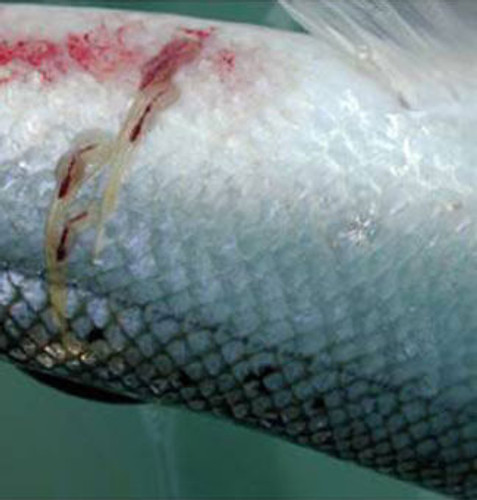
Anchor Worms & Fish Care
Anchor worms, also known as lernea, are small worms that are visible to the naked eye. They attach themselves to fish and will cause harm when they do so. They are typically found near the base of...
Bacterial ailments are a common problem among pond fish. They typically manifest themselves whenever the conditions within the pond, such as the quality of the water, are unfavorable. When oxygen levels within the pond are improper, the fish can also become stressed which makes them more susceptible to developing bacterial disease. These infections often result with fish dying during spring when the water becomes warmer and after the fish have become weakened throughout the winter.
Due to the fact that ponds are closed ecosystems, there are oth good and bad bacteria within them.The good bacteria can be found within the biological filter and it is an important part of the pond ecosystem because it breaks down the nitrate and ammonia so it can be eliminated by the water. Without good bacteria, no life could exist within your pond, or anywhere else for that matter.
However, bad bacteria also exists within a pond’s ecosystem. Bad bacteria are usually dormant until something happens which activates them. An example of this would be a fish that becomes injured or stressed. Once the fish’s immune system deteriorates, the bacteria will take advantage of it and reproduce rapidly, leading to sickness and additional problems.
Bad bacteria can also enter the pond’s ecosystem if new fish or plants are introduced into the pond without taking the time to quarantine them to ensure that they don’t have any harmful bacteria.
Becoming familiar with some of the most common bacteria and taking precautions to protect them is the wisest course of action.
Some examples of common bacteria that pond owners will encounter include fish tuberculosis, vibriosis and fin rot.
Vibrosis: Vibriosis is caused by an infection of Vibrio bacteria species. Severe Vibrio strains may enter a fish system that ignores strict quarantine practices. Immune-compromised fish, such as those stressed by poor water quality, bullying or lack of sufficient nutrition, are more susceptible to infection.Vibrio bacteria are known to be more problematic in warmer temperatures. Signs of Vibrosis are, Red fins or mouth, operculum and eyes,Exophthalmia and corneal opacity,Loss of Apetite and Pale gills.
Fin rot: While there are many causes for fin rot in a fish, one is the bacterial infection from thePseudomonas fluorescens bacteria. Fin rot can also occur from a fungal infection, which rots the fin more evenly and often produces a white “edge”. Sometimes, both types of infection are seen together. Infection is commonly brought on by bad water conditions, injury, poor diet, stress, or as a secondary infection in a fish which is already stressed by other disease.
Fin rot starts at the edge of the fins, and destroys more and more tissue until it reaches the fin base. If it does reach the fin base, the fish will never be able to regenerate the lost tissue. At this point, the disease may begin to attack the fish’s body; this is called advanced fin and body rot.
Fish Tuberculosis: Fish that are suffering from fish tuberculosis will usually develop a reduced appetite, become emaciated and their skin will become pale. They will also become lethargic. The disease will expand slowly until the fish dies.
Aeromonas: Aeromonas bacteria are one of the most common types of pathogenic bacteria. It is very active in the early spring when fish are stressed from overwintering and their immune systems are compromised. Aeromonas bacteria are usually the cause behind ulcers.
Our team at Fitz’s Fish Ponds is highly experienced in dealing with the various bacteria that negatively impact the pond’s ecosystem and the fish that live in it. We recognize that the majority of bacterial problems result in water conditions and quality, how new fish and plants are introduced into the pond’s ecosystem and diseased fish. We we can help you identify the cuase of the bacteria in your pond and help you to implement preventive measures that can help your fish avoid disease caused by bacteria.
Some of these measures include scheduled cleanings and water maintenance, identifying and removing fish which are diseased or deceased from the pond, treating fish which are ill, and avoiding injuries among the fish by constructing a safer environment.
Contact Fitz’s Fish Ponds today to eliminate any bacteria problems you have in your fish pond!
Fitz's Fish Ponds is an industry leader when it comes to treating Bacteria in New Jersey. Find out more about our pond fish care services!

Anchor worms, also known as lernea, are small worms that are visible to the naked eye. They attach themselves to fish and will cause harm when they do so. They are typically found near the base of...
FULL
SERVICE
We handle all aspects of your project
4.9
Average Google rating Over 600 reviews
5k+
Happy
Clients

We work
internationally

Consultation: Discuss your vision with our experts.

Custom Design: Receive a tailored pond plan.

Proposal: Review project timeline and costs.

Construction: Watch your dream pond come to life.

Support: Enjoy ongoing maintenance services.
